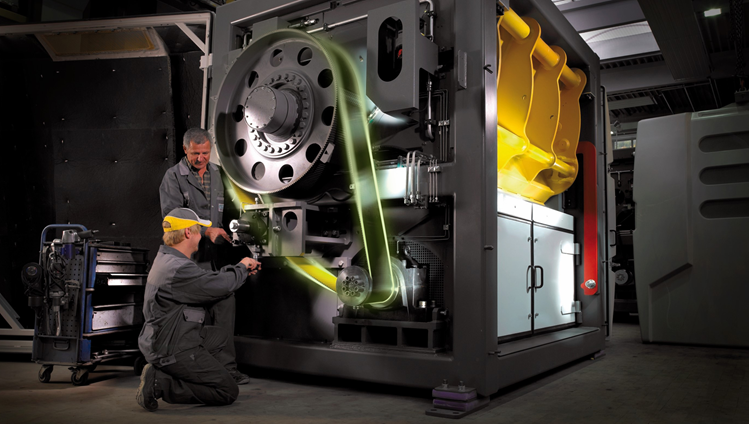Drive belts are elementary for industrial applications and the correct tensioning can contribute to energy-efficient operations.
 In times of high energy prices and limited natural resources, it’s clear: every little step counts. Using energy-efficient LED lights instead of lightbulbs. Using energy-efficient electric devices. Switching off the standby function. These are just some of the small measures every single one of us can take to save energy. But how about industries? They, too, consume a lot of energy to produce all kinds of goods, from steel for construction to paper for school books. How can they become more energy-efficient? For one, they could optimize the maintenance of the belts driving their machines – a small task with a big impact.
In times of high energy prices and limited natural resources, it’s clear: every little step counts. Using energy-efficient LED lights instead of lightbulbs. Using energy-efficient electric devices. Switching off the standby function. These are just some of the small measures every single one of us can take to save energy. But how about industries? They, too, consume a lot of energy to produce all kinds of goods, from steel for construction to paper for school books. How can they become more energy-efficient? For one, they could optimize the maintenance of the belts driving their machines – a small task with a big impact.
One concrete example comes from the cement industry where V-belt drives are used and machines operating at 75 kW (~100HP) are quite common. The annual energy consumption of such a drive comes in at 657.000 kWh if it runs continuously for 24 hours, 365 days a year. Considering a natural energy loss due to inevitable friction in the drive system of about 5 percent, this drive transmits a total of 624.150 kWh to the driven part. But if the V-belt drive is poorly maintained and the belt tensioning is inadequate the slippage between belt and pulley can easily increase, for example, by an additional 8.5 percent. Due to this slippage, the machine would lose another 53.000 kWh of energy per year or the equivalent of 32 persons’ yearly electricity consumption – ovens, hair dryers, smartphones, refrigerators, kettles, TVs, lighting, notebooks. The yearly energy need of a medium-sized apartment building – wasted by a single set of V-belts.
Make Power Smart app is a maintenance toolbox for the pocket
That is why proper maintenance is so important when it comes to industrial belts, for V-belts can lose tension over time and the resulting slippage is hardly visible to the naked eye. But as the example shows, well-tensioned belts can make a significant contribution to saving energy. Continental now offers digital help to achieve this: the Make Power Smart smartphone app which can be downloaded free of charge from the Apple App Store and the Google Play Store and which provides industrial users with a toolbox readily at hand for optimally tensioning their belts.

The highlight: without any further technical aid, the current tension of the belt to be serviced can be measured and the target tension calculated. Slippage can thus be effectively reduced. In the "Calculation" function, you first enter the basic drive parameters such as belt model and length, pulley diameter, speed and motor power. The system then uses the equivalence between the tension force and the vibration frequency of the free span of the belt to calculate the target belt tension. To measure the tension the drive must be turned off, then you strike the belt like a guitar string using a screwdriver or similar tool and record the resulting sound using the app's "Tension" function. It then determines the frequency value, which is compared with the previously calculated target value, giving you the feedback about how well the belt is tensioned. With this information, you can simply increase or decrease the belt tension until the two values match. It's as straightforward as tuning a guitar – except that the benefits for the company and ultimately our environment are infinitely greater.
Numerous functions for optimal maintenance
In addition, the app offers further functions that simplify everyday belt maintenance in industrial applications and sometimes significantly reduce downtimes. With the "Belts" function, for example, managers can identify the belt they are using and find the best alternative for the application that would match preset requirements at the touch of a button.
The "Pulleys" function helps to find out important key dimensional figures of the belt drive with the help of a photo alone. To do this, users can take a frontal picture of the two pulleys in the app. With just one reference, for example one pulley diameter, the app automatically calculates the diameter of the second pulley, the center distance between the pulleys and the wrap angle.
In the "Alignment" function, the misalignment of two pulleys can also be determined with the help of a photo and interactive tools. Non-parallel pulleys are one of the main reasons for belt wearing. Under "Motor", a photo and key characteristics of the driving motor can be stored. This data is also helpful for calculation. All these functions in an app ultimately are small levers to optimize belt maintenance in an industrial environment and thus helps industries of all shapes and sizes to improve their energy efficiency. And with every well-tensioned belt, the overall impact will become bigger and bigger.
Video: Small Lever, Big Impact